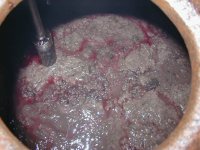SPYDERLK
Super Star Member
- Joined
- Feb 28, 2006
- Messages
- 12,502
- Location
- VA
- Tractor
- JD2010, Kubota3450,2550, Mahindra 7520 w FEL w Skid Steer QC w/Tilt Tatch, & BH, BX1500
One of the challenges of Physics is to explain observed events while maintaining strict avoidance of fantasy entering the science. To do this it is counterproductive/confusing to introduce variables out of turn. Sure water is a phase change substance - most things are but is it changing phase here? Lets bypass this a minute. -- Heat transfer is a function of delta T. However a hot surface in contact with tap water can form bubbles even below the point of actually boiling. These are dissolved gases leaving the water. These bubbles, starting as an infinitismal discontinuity, act as nucleation sites for evaporation of water. So the bubbles are mostly gaseous water in the long run, having been started by a spec "impurity" of O2, N2, Cl, etc escaping from solution. These "specs" themselves have formed at surface discontinuities in the vessel containing the water. Everyone sees this happen as they bring tap water to a boil. The issue is that these micro and growing bubbles forming in the mold "vessel" get in the way of water touching the walls of the flowpath thru the mold. The gas layer is an insulator. Now consider the effect of turning down the outlet valve. The water, now under pressure does not form any, or as much, gaseous H20 layer adjacent to the heat source.I spent some years as a mold maker for the injection molding biz. My molding room manager had a trick for increasing the cooling rate and shortening the time to cycle a mold. He'd turn the outlet valve down, closing the flow some forcing the water to say in the mold longer & cooling the mold more effectively. This (he contended) let the water (a phase change material) absorb more heat energy faster, because as he said water being a phase change material has a variable ability to take up energy. this ability changes dramatically as it takes on energy andchanged temperature. There are thermal regiems during which it takes up energy slowly and others where it does so rapidly. His contention was that if he kept the water in the mod just a wee skosh (pardon the highly technical terms) longer, it'd take up a lot more thermal energy and cool the mold more rapidly.
He was correct. the molds cooled faster and that let him run faster cycle times.
SOOOOOOOOOOO Logically allowing the coolant to stay in the heat exchanger a little longer will cause an uptick in energy transfer, improving cooling capacity for the benefit of the engine.
SOOO The "logic" of [allowing the coolant to stay in the heat exchanger a little longer will cause an uptick in energy transfer] is not logic but happenstance based not on time but on pressure.
As for a t stat improving cooling capacity it does not. The undeniable benefit the t stat offers is keeping the engine at a relatively constant temp regardless of the workload and the ambient temperature. It does this by sensing coolant temperature and adjusting flow restriction to warm it quickly to the design temp and then constantly react to hold it there. It opens further and further, increasing flowrate, as the cooling needs increase. This works beautifully while the system is working nominally to its design, usually a long time. But finally things degrade to where overheating occurs. Maybe the t-stat is bad and will no longer open to its full extent. Maybe the radiator is cruddy inside or out. Maybe the fan belt is slipping. Maybe the head gasket is allowing a little combustion gas into the coolant jacket. Maybe a whole combination of things; its an old system variously maintained and, now, has been overheated.
If the t stat is bad and you change it it will act normal again, overcoming all the other problems of degradation; either a fix or a "fix". If the tstat is good and you remove it you will get a "fix" with problems lurking, either above, at, or below the horizon. Problems will not be because the fluid is dwelling anywhere too briefly to transfer heat - transferring half as much heat 3 times as often is the kind of thing that would actually happen.
- What could upset this physical truth?; *)An already slipping fan belt exacerbated by the water pump requiring more power to pump more fluid, *)an internally restricted radiator core causing much of the fluid to cross the top tank to feed the core channels that most directly flow to feed the increased suction from the bottom exit hose to the pump, *)bubbles/microboiling in the violently flowing heated fluid as it traverses the suction hose and impeller and then onward into the engine they act as nucleation sites growing and insulating from optimum heat transfer, *) Etc.
It would take chapters in an appropriate textbook from authors much more knowledgeable and lucid than myself to skirt simplisms that so easily creep into things that seem simple. The best of them can do it like a Carl Sagan story. IVE talked to maybe a couple people like that in a lifetime. Its the easiest way to learn ... and learning is progress.
Im going to get on back to the thread. Have we solved Danicas engine fade yet?
